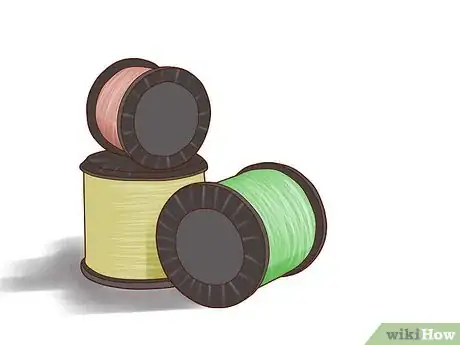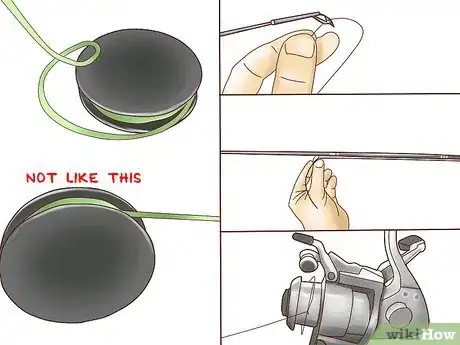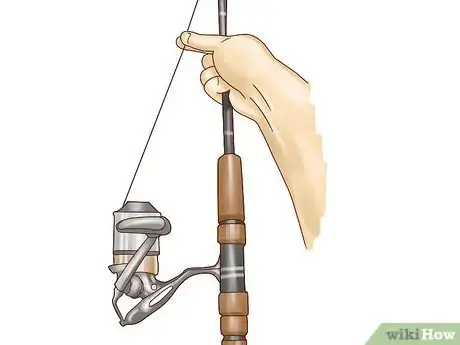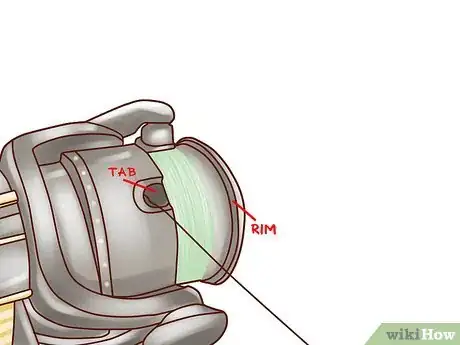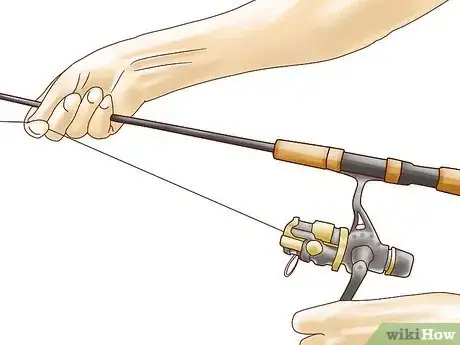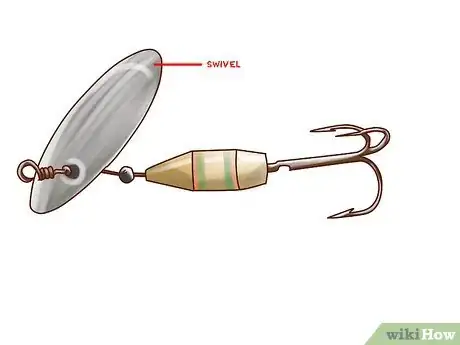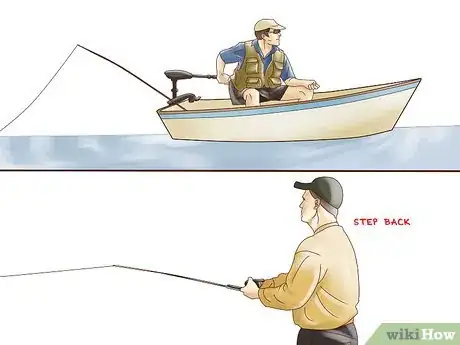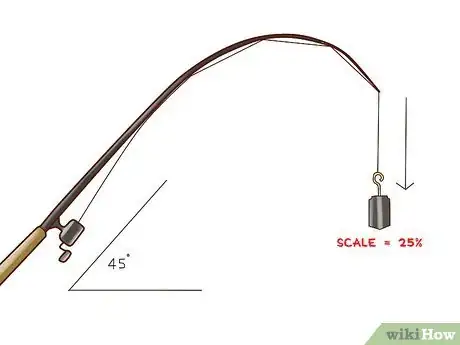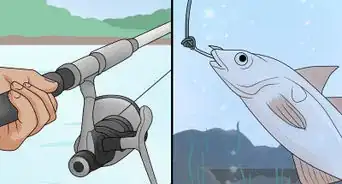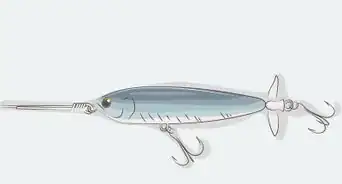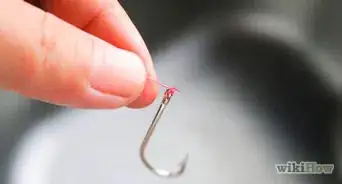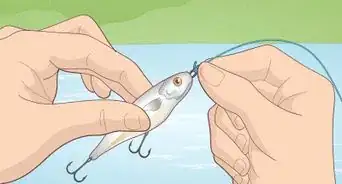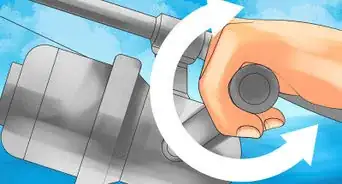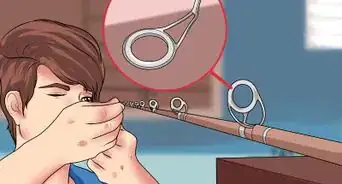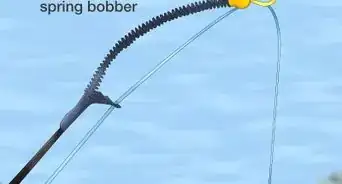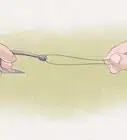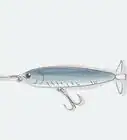X
wikiHow is a “wiki,” similar to Wikipedia, which means that many of our articles are co-written by multiple authors. To create this article, 30 people, some anonymous, worked to edit and improve it over time.
This article has been viewed 321,379 times.
Learn more...
Spinning reels are ideal for making long casts, especially with small lures, but the line can kink up, twist, loop, break, and make the fishing experience one big headache if you don't know what you're doing. This article will show you some tricks to keeping the line trouble-free, and keeping your outing stress-free.
Steps
-
1Choose the right line. Stiff line will loop off and be unruly, giving you nothing but trouble. Choose a line that says it is limp and can be cast, and stay within the pound-test guidelines on the reel itself. If the reel says it will hold 140 yards (128.0 m) of 4-pound-test, 120 yards (109.7 m) of 6-pound-test, and 100 yards (91.4 m) of 8-pound-test, don’t buy line over 8-pound-test. If you need stronger line than that, get a different reel.
-
2Put the spool of line on the floor, label up. Run the line through the guides on the rod to the reel with the bail open and tie it tightly to the spool. If you use a regular overhand square knot, pass the end through twice instead of just once – it will help keep the line tight on the spool. Close the bail.Advertisement
-
3Hold the line between your fingers about a foot in front of the reel while you wind the handle to put line on the reel. After a few seconds, lower the rod toward the spool of line. If the line kinks up and twists, turn the spool over so the label is toward the floor and start again. It’s normal for it to make big loops – what you’re watching for is twisting.[1]
-
4Keep pressure on the line in front of the reel while you turn the reel handle to fill it. Do NOT overfill the spool. Leave between an eighth and a quarter inch of the rim showing. Overfilling is a major cause of looping and problems with spinning reels.[2]
-
5Keep the line taut. After you make a cast with a spinning reel, use your fingers in front of the reel to put tension on the line until the weight of the lure in the water puts a bit of tension on it. Reeling in loose line is a sure-fire way to get loops on your spool. Once the line is taut you can let go and reel normally.
-
6Use a swivel in front of the lure if you are using lures that typically cause twisting. Plastic worms, inline spinners (Mepps, etc.) and spoons often cause twist and will benefit from a swivel.[3]
-
7Untwist the line. If you do get some line twist, the line will twist up as you reel it in, causing loops all over the spool and making it difficult to cast. If this happens:[4]
- Take the lure off and simply let the line out behind the boat as you travel down the lake. Let as much line out as you can, and when you stop, wind it back on. Be sure to hold it taut while you wind it on.
- Another solution is to tie the end of your line to something, then walk away while letting the line out. Pull on the line when you get enough off, to stretch the line slightly and remove kinks. Cut the end of the line free before re-winding it back onto the reel. Don’t stretch the line too much or you will weaken it. Just put a little pressure on it.
-
8Set the drag. The drag is the mechanism that allows line to spool off with the bail closed. This lets line off slowly if a big fish bites, so that it doesn’t break the line. To set the drag, leave the bail closed and pull on the line in front of the reel. It should take a fair amount of pressure to make the line come out. If you catch a small fish and it takes the drag out, tighten it. If a big fish starts to pull real hard and you think the line is going to break, loosen the drag. Simple as that. Some spinning reels have the drag knob in front and some are in back. Get familiar with your reel before you go out.[5]
- Stop reeling if you are fighting a fish and the drag is going out. Reeling while the drag is going out will twist your line, and it is futile anyway. Use your hand on the spool to get control over the fish, or tighten the drag if you need to.
- The best way to set your drag is to use a scale and set it to 25% of the strength of the line. The scales are expensive, but some tackle shops have them. The pull and feel method works just fine for a fun-fisherman.
-
9Feel your line near the lure for nicks and frays every once in a while when you are fishing. If you feel any, cut off above the rough spots and re-tie.
Advertisement
Community Q&A
-
QuestionWhen casting, should the reel be loosen or tightened?
 Community AnswerThe drag can be at the desired setting as it does not affect your cast. When using a spinning reel, you need to flip over the bail to cast.
Community AnswerThe drag can be at the desired setting as it does not affect your cast. When using a spinning reel, you need to flip over the bail to cast. -
QuestionMy line builds up on one end of the spool. Any suggestions?
 Community AnswerIt depends on the type of reel, but if it's a spinning reel, you may be able to add a washer under the spool to adjust how it lays the line.
Community AnswerIt depends on the type of reel, but if it's a spinning reel, you may be able to add a washer under the spool to adjust how it lays the line.
Advertisement
Warnings
- If you opt for braided line, never try to bite it (it's not a good idea with any type of fishing line, but especially braided). Use scissors. There are also special clippers for braid.⧼thumbs_response⧽
- If you let a child use braided line, you must remain constantly vigilant. Don't rely on a child to remember not to pull on the line.⧼thumbs_response⧽
- Never discard any fishing line except in designated receptacles. It causes havoc (or death) to many thousands of birds, turtles, and fish every year. Even small pieces can cause trouble. Most tackle shops have recycle bins for used fishing line, and many lakes have line recycling receptacles near the boat ramp.⧼thumbs_response⧽
- With braid, if you get snagged, do NOT pull on the line with your hands. Braid is so strong it can cut you badly. Instead, wrap the line around your pliers or scissors and pull. Usually, braid is so strong it will straighten out the hooks and you'll get your lure back.⧼thumbs_response⧽
Advertisement
References
- ↑ https://www.wired2fish.com/how-to-bass-fish/3-ways-to-reduce-spinning-reel-tangles/
- ↑ https://www.wired2fish.com/how-to-bass-fish/3-ways-to-reduce-spinning-reel-tangles/
- ↑ http://www.bishfish.co.nz/tips/linetwist.htm
- ↑ http://www.bishfish.co.nz/tips/linetwist.htm
- ↑ https://www.youtube.com/watch?v=L7v-XIibcUc
About This Article
Advertisement
